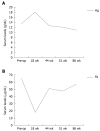Incidence and risk factors for the development of anemia following gastric bypass surgery
- PMID: 20397264
- PMCID: PMC2856827
- DOI: 10.3748/wjg.v16.i15.1867
Incidence and risk factors for the development of anemia following gastric bypass surgery
Abstract
Aim: To evaluate the incidence and risk factors for the development of anemia after Roux-en-Y gastric bypass (RYGB).
Methods: A retrospective analysis of patients undergoing RYGB from January 2003 to November 2007 was performed. All patients had a preoperative body mass index > 40 kg/m(2). A total of 206 patients were evaluated. All patients were given daily supplements of ferrous sulfate tablets for 2 wk following their operation. Hematological and metabolic indices were routinely evaluated following surgery. Patients were followed for a minimum of 86 wk.
Results: There were 41 males and 165 females with an average age of 40.8 years. 21 patients (10.2%) developed post-operative anemia and 185 patients (89.8%) did not. Anemia was due to iron deficiency in all cases. The groups had similar demographics, surgical procedure and co-morbidities. Menstruation (P = 0.02) and peptic ulcer disease (P = 0.01) were risk factors for the development of post-operative anemia.
Conclusion: Iron deficiency anemia is frequent. RYGB surgery compounds occult blood loss. Increased ferrous sulfate supplementation may prevent iron depletion in populations at increased risk.
Keywords: Anemia; Complication; Gastric bypass surgery; Obesity.
Figures
References
-
- Frezza EE, Moreland A. Anemia after gastric bypass: still a risky business? South Med J. 2008;101:983–984. - PubMed
-
- Mizón C, Ruz M, Csendes A, Carrasco F, Rebolledo A, Codoceo J, Inostroza J, Papapietro K, Pizarro F, Olivares M. Persistent anemia after Roux-en-Y gastric bypass. Nutrition. 2007;23:277–280. - PubMed
-
- Alvarez-Leite JI. Nutrient deficiencies secondary to bariatric surgery. Curr Opin Clin Nutr Metab Care. 2004;7:569–575. - PubMed
-
- Avgerinos DV, Leitman IM, Martínez RE, Liao EP. Evaluation of markers for calcium homeostasis in a population of obese adults undergoing gastric bypass operations. J Am Coll Surg. 2007;205:294–297. - PubMed
Publication types
MeSH terms
LinkOut - more resources
Full Text Sources
Medical
Research Materials



